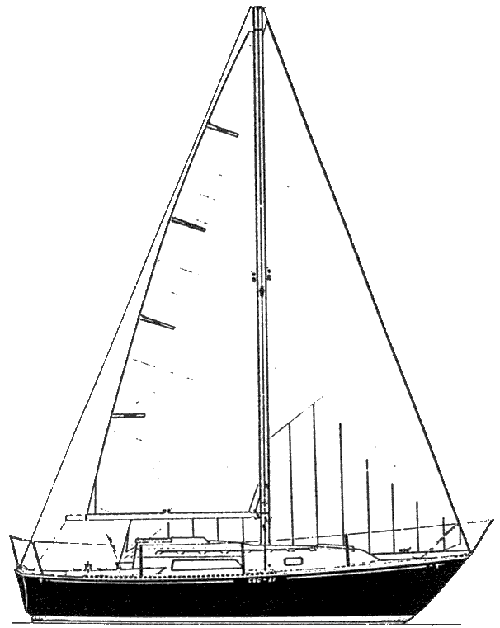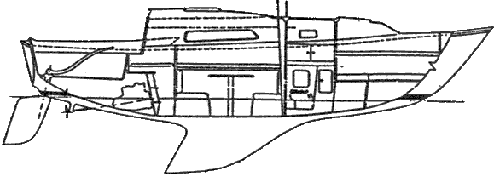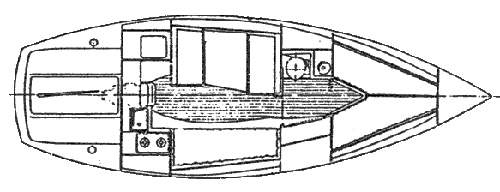
C&C 27 Overview – General Description & Features
This page provides:
- a general description of the original C&C 27 on deck and below;
- its performance, including a polar diagram for the Mark III;
- notes on costs and value;
Detailed specifications for the C&C 27 Marks I to IV are available in Evolution. Information on the C&C 27 Mark V is available in Sea Change. The images on this page show the C&C 27 Mark I; see the Evolution section for images of a Mark IV and Sea Change for the Mark V.
On Deck and Below
The C&C 27 has all the C&C hallmarks: a springy sheer, attractive bow profile and a well integrated cabin trunk. Thank you, George Cuthbertson, for the gracious lines of the C&C 27. The C&C 27 also enjoys a generous beam, reasonably high topsides, short overhangs, and a wide transom. Her keel is vintage C&C, with a sharply swept back leading edge. The Mark I and II have the scimitar-shaped rudder, which is long in the chord and shallow in depth. The Mark III and IV have a high-aspect-ratio rudder, with constant chord length, and greater depth.
On Deck The foredeck is spacious, with the mast set well back. The raised coach roof comes up at a low angle from the high, cambered deck. Sloping side decks are of reasonable width, running out at the cockpit coamings, and the cockpit is big enough to handle a post-race victory party. The overall feeling from the deck is of a comfortable, well proportioned sailing yacht.
Below Decks As you descend through the main companionway, you'd swear she's a much bigger yacht. The 27 has all the creature comforts. The galley is both to port and starboard. This layout makes for plenty of counter space. The stainless sink and stove are to starboard, and a large icebox is to port under the counter. Lockers, drawers, shelves and storage space abound. The roomy main saloon offers standing headroom. To port the dinette seats four, and at night the table drops down to form a large single berth. A six-foot-plus single settee berth is to starboard. The head is forward and to port, with a large, open hanging locker opposite. A full length door separates the head from the saloon. The spacious V-berth will comfortably sleep two adults, and there is a folding door to close this area off from the head.
Performance Characteristics
The C&C 27 has always been a performer. Thirty-plus years after the first boats were built, 27's continue to race (and cruise) on all the Great Lakes, and they enjoy any condition the lakes can provide. In the PHRF racing circuit, the C&C 27 has been a competitor for many years. Any 27 which is well sailed can be a club champion, and many are (see polar diagram). Several clubs on western Lake Ontario actually have enough 27's to have their own one-design fleet for club racing (see Links).
Between races, the 27 is a very comfortable and trustworthy cruiser. The Marks I and II are very stable boats, able to carry maximum sail area in stronger winds. George Cuthbertson originally designed the Mark I for ocean sailing. By comparison, the Mark III and IV move smartly in lighter airs, which the Great Lakes are afflicted with in July and August, when many other boats this size simply do not have enough rig to sail acceptably. All the 27's reach very well. They easily keep up with the fleet from port to port, and usually lead the cruising sailboats under 30 feet.
Commercial Notes
The C&C 27, a Canadian classic, represents a low-cost alternative for those wishing to buy a moderately-sized, high-performance racer-cruiser. They are an excellent example of how long a properly built fibreglass boat can last, with a proven reputation as strong, well-designed and well built boats. The fact that these boats continue to race successfully at both club and interclub levels, is testimony to their heritage.
The C&C 27 is also one of the reasons many yacht manufacturers have gone out of business. With nearly 1,000 hulls produced, most have shown no serious signs of aging. There are neglected 27's (a condition that often shows up as delamination of the deck, but any potential purchase should be inspected by a competent surveyor), but most of the hulls are in a well maintained state, and have no foreseeable retirement.
New sailboats of similar size cost approximately $60,000 to $80,000, and depreciate rapidly in the first year. Currently (in the late 90's), it is possible to buy a well-kept C&C 27, 12 to 25 years old, for about a third of the replacement cost. As many new owners on a budget will agree, a well equipped 27 can be acquired for under $20,000, ready to race and/or cruise. Later model 27's in pristine condition list for $25,000 plus.
Despite the variations in the four different C&C 27 versions, all boats race together without handicapping. To equalize these variations, the Association has developed maximum permitted sail measurements for each of the four different rigs (see below). It has been "generalized" that the Marks I and II place higher in heavy air races, and that lighter winds bring out the best in the Marks III and IV. These generalizations are usually put to the test each season by the performance of certain skippers. To clarify the differences in the four different versions, and the adjustments made to equalize their performances, the following tables can be used.
Class Overview
The C&C 27 has always been an affordable one-design racer/cruiser. To keep things both friendly and affordable, the 27 Association has adopted the following sail material regulations.
- Mainsails – laminated materials and loose-footed mainsails are permitted.
- Genoas – no material restrictions.
- Spinnakers – restricted to nylon.
The flexibility in genoa materials keeps the boats competitive for club racing, and has not been a problem within the Association. Frankly speaking, there are no millionaires lining up to buy a C&C 27 championship, and many 27's sail competitively with well seasoned canvas.



